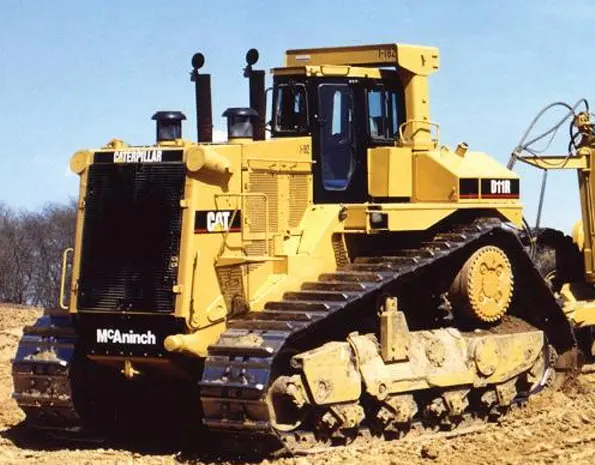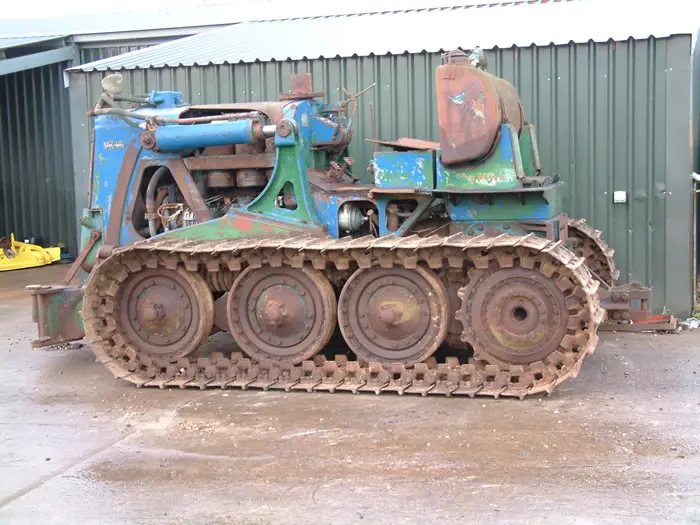ha ha ... hey thanks Bob 😄
Where in heck have you been hiding, late technology getting your attention ? it's an interesting prototype, hopefully it will pan out, but I do wonder how it's going so far with that new model working in the proving grounds.
Thanks Bob,yes I did notice that its an oval track and rightly so too,the bloke trying to explain about it sounds like he spent the night in a bar,I worked on diesel electric dozers 50 years ago,there were electric drive tractors back in the 1930s and trucks going back to the 1880s so its about time the concept was perfected,no mention of why they have reverted back to the oval track design,someone at Cat might have seen one of your old posts.
AJ
Thanks Bob! It was very interesting to view the link. Again, the explanation for reverting to the oval track design was unsatisfactory. The focus, of course, was on the diesel/electric feature. Joystick control sure beats the manual shift on our antique Cats when it comes to moving earth or plowing snow in a confined area. GWH
You have a wonderful day. Best wishes. Deas Plant.
Hello, D8Bob/Dozer 575/et al.
You'll get no thanks from me. You have apparently just discovered this article, EIGHT MONTHS after it was first published and posted on this and other sites. You have chosen to post the link here for your own self-serving and pot-stirring ends. I very seriously doubt that you had even the slightest thought of advancing the 'edjewmackayshun' of any of the members/readers here.
As I have mentioned in various threads on several forums in the past, you occasionally, just OCCASIONALLY, put up a good post. Trouble is they are few and far between and this is NOT one of them. If you can't post sensibly about topics that are not self-serving and stirring the pot, may I suggest that you go back to your Washington woods and leave the rest of us to get on with the REAL business of this and similar forums, that of discussing vintage tractors and sharing knowledge and information about same.
Hi, GWHdiesel75.
I may be being a little simple here but I think the following quote from the article explains the logic behind the D7E electric drive crawler being oval track fairly well, especially to those who have some experience of both types of track systems.
Quote:
"We carefully evaluated all of the kinds of work that a D7 does, and decided the low-drive undercarriage configuration is the best choice for the job," Nicoll explains. "You get the greatest value out of elevated-sprocket undercarriage when it is suspended, and only the D8 and larger sized elevated sprocket undercarriages are suspended. Certainly we will continue to use the elevated-sprocket undercarriage on the D8 and larger tractors."
Unquote.
To my mind, there is no discernible difference in either ride quality or tractive ability between the D7G's and the later high-sprocket drive models. The ride improvements from the high-sprocket drive system depend totally on the fact that the front and rear idlers are on rocker beams with the front and rear roller bogies. This reduces shocks to the rest of the tractor by halving the movement transferred if an idler encounters an obstacle. The high-sprocket D7's and down don't have this feature.
The improved traction of the larger Cat high-sprocket models comes from the the suspended track system - rollers and idlers being on bogies and oscillating beams - which again the high-sprocket D7's and down don't have.
Even Komatsu have adopted the floating bogie system for their track rollers on their larger machines although, not as far as I can determine, including the front idler in with the front roller bogie. They claim that they don't have the front idler on an oscillating beam with the front roller bogie because the balance is better that way. I think they are missing out on part of the benefits of the roller bogie system. Just my 0.02.
One of the reasons that most of the Holt models were scrapped at or shortly after the merger with Best was the 'bend-in-the-middle' track frames that the Holt tractors had. It was felt that there were too many wearing parts. The longest survivor of the Holt models was the 2-Ton which didn't have this style of track frame. Then, 50 years later, Cat brings in a track system that has way more wearing parts than the old Holt systems. To use an American expression, "Go figure".
Deas, I didn't understand what a suspended undercarriage was. Your comments helped me to understand it, but not entirely. I am one of those Cat enthusiasts who is neither a mechanic nor an engineer. Oh, and some say I don't know a heck of a lot about operating machines. But I do have fun with them nevertheless. Thanks for your explanations. I'm uncertain what a boogy is. I know they are found in modern tracked tractors of various makes. GWH
Hi GWH,
Bogies refer to the paired track rollers and idler/roller pairs pivoting on a common axis. An effective means of distributed loads. The whole undercarriage front and rear is suspended and pivoted from a dead axle just below the drive sprocket.
Bogie suspension is very common to battle tank undercarriages but took quite a while to make it to tractors.....although some of the old logging arches used bogie suspension way back when.
Deas....didn't mean to steel you thunder.....feel free to modify my input😊 😊
Deas, I didn't understand what a suspended undercarriage was. Your comments helped me to understand it, but not entirely. I am one of those Cat enthusiasts who is neither a mechanic nor an engineer. Oh, and some say I don't know a heck of a lot about operating machines. But I do have fun with them nevertheless. Thanks for your explanations. I'm uncertain what a boogy is. I know they are found in modern tracked tractors of various makes. GWH


You have a wonderful day. Best wishes. Deas Plant.
Hi, GWHdiesel75.
Explanations: a 'bogie' is a pair or group of wheels arranged to pivot on one or more axis to enable them to share the load more less equally between them. In the case of the bogies in the Cat high-spropcket drive system, once they bogies drop away from the main track frame, they don't carry any weight at all other than their own weight resting on the track chain rails.
I have attached a photo of one of McAninch's D11R's that hopefully will give you an idea of the system and how it works. It shows the pivot point for the rocker assembly that carries the front idler and the front roller bogie. It also shows the pivot points for the other roller bogies, both where their carrier arms mount in the track frame and where the bogies themselves pivot at the end of their carrier arms. If you look carefully, you can also see the pivot point in the rear of the track frame where the rear idler rocker assembly pivots.
Strictly speaking, the Cat system is not a true 'suspended' system as it doesn't fully share the weight of the tractor on all its component rollers. idlers, etc., in the fashion that a tractor like the English-built Vickers did - see attached photo. However, the front and rear rocker assemblies with their idlers and attached roller bogies do share their load to some extent.
As mentioned in my previous post above, the smaller Cat high-sprocket drives don't have this bogie system. All track rollers and both idlers are solid-bolted to the track frame.
Hope this helps.
You have a wonderful day. Best wishes. Deas Plant.
Hi, Old Magnet.
Dammit, man, can't you mind your own business? LOL. Thanks for jumping in. The photo that you posted certainly gives another angle from which to view and understand the 'bogie' concept.